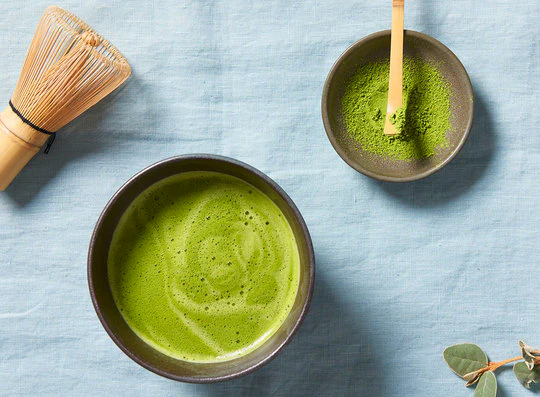What Does Matcha Taste Like? The Ultimate Guide to Matcha
Raise your hand if you made some sort of “treat your body better” resolution? If you did, good for you! And if you didn’t, me either. I was worried I’d just disappoint myself, but also I’m pretty happy with the balance of what I eat/drink.Whether you’re being intentional with goals or just working on being your best self, drinking daily matcha fits right into healthy ways to kick off the new year. So, I’m sharing this ultimate guide to matcha, complete with: what is matcha, the health benefits of matcha, what matcha tastes like, why I drink matcha, how and where to buy matcha, how to choose the best matcha tea, how to make matcha tea, and dozens of matcha recipes.My hope is that I inspire you to give matcha a solid try to see how it makes you feel. I’ll equip you with all the information you need to do so right here in this post.
What is matcha
Unlike other green tea that you steep and brew, matcha is the stone-ground powder of whole green tea leaves. Three weeks before harvest, farmers choose the highest-quality green tea leaves and shade them for slower growth. This shading boosts the chlorophyll, giving it a more intense green color than other green teas.It’s also the process that causes more theanine to grow, an amino acid that causes relaxation without feeling sleepy. See more information on the effects of theanine in the next section on matcha health benefits.
What does matcha taste like?
As a traditional Japanese drink, matcha powder is traditionally whisked up with hot water into a frothy drink meant for sipping. It’s also popular to mix it up with steamed milk for an everyday matcha latte, enjoyed like you would a morning cup of coffee.The result is a rich earthy tea with vegetal grassy notes, sweet nuttiness, and pleasant bitter undertones. In its most pure ceremonial form, whisked up with hot water, the flavor is more vegetal, but it can be dressed up with honey and milk for a sweeter morning drink.If you’re already saying “I’ve tried matcha and I don’t like it,” I hear you. I encourage you to skip ahead to the section on how to choose the best matcha tea and give it one more go! So much of your experience comes down to the quality of the matcha you drink. My hope is that this ultimate guide to matcha will help you start with great organic matcha.
How much caffeine in matcha?
Matcha has a profound effect on mood and energy. Since you consume the whole ground leaf, matcha green tea has more caffeine content than other brewed green teas. With about 60mg of caffeine per serving, the caffeine level is more comparable to that of black tea, or about ⅔ of the caffeine as a cup of coffee.The high theanine content described above combined with moderate caffeine gives drinkers a calm alertness, what some refer to as “zenergy.” While it provides a morning boost, it does so in the form of alert concentration that doesn’t give you the jitters or crash like coffee does. I’ll tell you more about this energy boost in the section on why I choose matcha over coffee.
Matcha Health Benefits
Matcha is packed with antioxidants, vitamins, and minerals. It’s a superfood that provides a concentrated dose of nutrients and health benefits. Here are some of the top reasons to drink matcha:
- High in antioxidants – Matcha is packed with antioxidants called polyphenols, which help fight free radicals and oxidative stress in the body. It has 137 times more antioxidants than regular green tea.
- Boosts metabolism – The catechins in matcha may help increase your metabolism and fat burning, especially during exercise.
- Detoxifies the body – Chlorophyll in matcha helps remove heavy metals and toxins from the body.
- Calms and focuses the mind – The amino acid L-theanine in matcha promotes a state of relaxed alertness. It helps you feel calm and focused without drowsiness.
- Strengthens the immune system – Matcha is packed with vitamins and minerals like vitamin C, selenium, chromium, zinc and magnesium which support immune function.
- Lowers cholesterol and blood sugar – Studies show matcha may help lower LDL cholesterol and blood sugar levels.
- Boosts energy – With about 60mg of caffeine per serving, matcha provides a steady energy boost without the jitters or crash of coffee.
Why I Choose Matcha Over Coffee
I’m a big fan of matcha and drink it daily. Here’s why I choose matcha over coffee:
- Steady energy boost without jitters or crash – The combination of caffeine and L-theanine in matcha provides a calm, focused energy boost that lasts for hours without the crash of coffee.
- Packed with antioxidants and nutrients – Matcha is a superfood packed with antioxidants, vitamins and minerals that provide a concentrated dose of nutrition.
- Supports detoxification – The chlorophyll in matcha helps remove heavy metals and toxins from the body.
- Promotes relaxation and focus – L-theanine in matcha promotes a state of relaxed alertness, helping you feel calm and focused without drowsiness.
- Versatile – Matcha can be enjoyed on its own, whisked into a latte, or added to smoothies, baked goods, and recipes.
How to Make Matcha Tea
Here’s how to make a traditional matcha tea:Ingredients:
- 1-2 tsp matcha powder
- 2-4 oz hot water (175°F)
- Bamboo whisk (chasen)
- Matcha bowl (chawan)
- Bamboo spoon (chashaku)
Instructions:
- Sift the matcha powder into the bowl using a fine mesh strainer or sifter. This helps break up any clumps.
- Add a small amount of hot water (about 2 tbsp) and whisk vigorously in a zig-zag motion until a smooth paste forms.
- Add the remaining hot water and continue whisking in a zig-zag motion until the tea is frothy.
- Drink immediately while hot.
Tips:
- Use a bamboo whisk for best results. Stainless steel can scratch the bowl.
- Whisk in a zig-zag motion, not in circles. This incorporates more air for a frothy texture.
- Drink matcha right away for best flavor and texture.
- Adjust water temperature to taste. Hotter water (up to 195°F) makes a stronger flavor, cooler water (165°F) is smoother.
Matcha Latte
For a creamy matcha latte:Ingredients:
- 1-2 tsp matcha powder
- 2-4 oz hot water (175°F)
- 6-8 oz steamed milk of choice
- Honey or sweetener (optional)
Instructions:
- Sift the matcha into a bowl or mug.
- Add a small amount of hot water and whisk into a smooth paste.
- Add the remaining hot water and whisk until frothy.
- Steam milk until hot and frothy. Gently pour into the matcha.
- Sweeten to taste with honey or sweetener if desired.
Tips:
- Use a milk frother or steam milk to add creaminess.
- Adjust matcha and milk ratios to taste. More matcha makes it stronger, more milk makes it creamier.
- Vanilla, cinnamon or other spices make tasty additions.
Matcha Recipes
Matcha is a versatile ingredient that can be used in all kinds of recipes. Here are some ideas:
- Matcha smoothie
- Matcha overnight oats
- Matcha chia pudding
- Matcha energy bites
- Matcha cookies or brownies
- Matcha ice cream
- Matcha muffins or scones
- Matcha protein bars
- Matcha lemonade
- Matcha milkshake
Conclusion
Matcha is a delicious, nutrient-dense superfood that provides a host of health benefits. With its rich, creamy flavor and versatility, it’s no wonder matcha has become so popular. By choosing a high quality organic matcha and enjoying it regularly, you can experience the benefits of calm, focused energy, antioxidant support, and overall wellness. I hope this ultimate guide to matcha has inspired you to give it a try!
| Comparison | Matcha | Green Tea |
|---|---|---|
| Caffeine Content | 60mg per serving | Lower than matcha |
| Antioxidant Content | Higher than green tea | Lower than matcha |
| Flavor | Rich, creamy, earthy with sweet, grassy notes | Lighter, more delicate flavor |
| Preparation | Powder whisked with hot water | Leaves steeped in hot water |
| Nutrients Consumed | Entire leaf consumed | Leaves removed after steeping |



